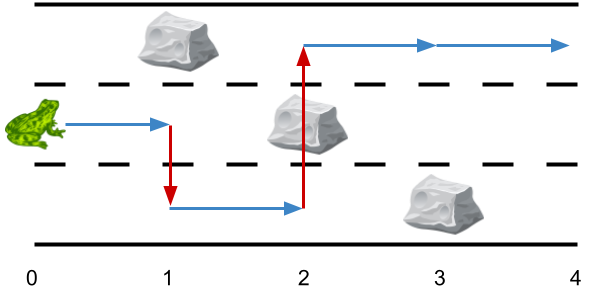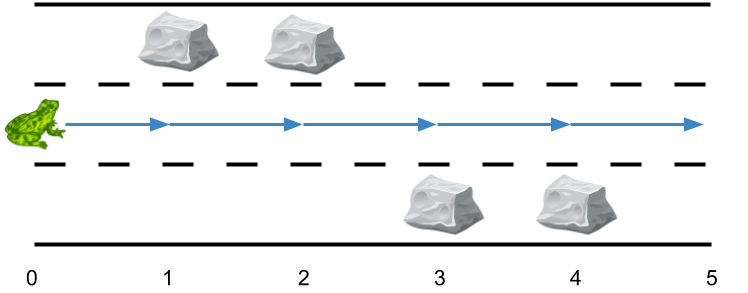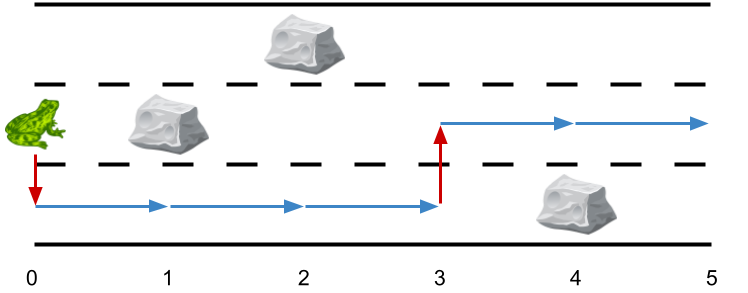There is a 3 lane road of length n that consists of n + 1 points labeled from 0 to n. A frog starts at point 0 in the second lane and wants to jump to point n. However, there could be obstacles along the way.
You are given an array obstacles of length n + 1 where each obstacles[i] (ranging from 0 to 3) describes an obstacle on the lane obstacles[i] at point i. If obstacles[i] == 0, there are no obstacles at point i. There will be at most one obstacle in the 3 lanes at each point.
- For example, if
obstacles[2] == 1, then there is an obstacle on lane 1 at point 2.
The frog can only travel from point i to point i + 1 on the same lane if there is not an obstacle on the lane at point i + 1. To avoid obstacles, the frog can also perform a side jump to jump to another lane (even if they are not adjacent) at the same point if there is no obstacle on the new lane.
- For example, the frog can jump from lane 3 at point 3 to lane 1 at point 3.
Return the minimum number of side jumps the frog needs to reach any lane at point n starting from lane 2 at point 0.
Note: There will be no obstacles on points 0 and n.
Example 1:
Input: obstacles = [0,1,2,3,0] Output: 2 Explanation: The optimal solution is shown by the arrows above. There are 2 side jumps (red arrows). Note that the frog can jump over obstacles only when making side jumps (as shown at point 2).
Example 2:
Input: obstacles = [0,1,1,3,3,0] Output: 0 Explanation: There are no obstacles on lane 2. No side jumps are required.
Example 3:
Input: obstacles = [0,2,1,0,3,0] Output: 2 Explanation: The optimal solution is shown by the arrows above. There are 2 side jumps.
Constraints:
obstacles.length == n + 11 <= n <= 5 * 1050 <= obstacles[i] <= 3obstacles[0] == obstacles[n] == 0
class Solution:
def minSideJumps(self, obstacles: List[int]) -> int:
f = [1, 0, 1]
for v in obstacles[1:]:
g = [inf] * 3
for j in range(3):
if v != j + 1:
g[j] = f[j]
if v != 1:
g[0] = min(g[0], min(g[1], g[2]) + 1)
if v != 2:
g[1] = min(g[1], min(g[0], g[2]) + 1)
if v != 3:
g[2] = min(g[2], min(g[0], g[1]) + 1)
f = g
return min(f)class Solution {
private int inf = 0x3f3f3f3f;
public int minSideJumps(int[] obstacles) {
int[] f = new int[] {1, 0, 1};
for (int i = 1; i < obstacles.length; ++i) {
int v = obstacles[i];
int[] g = new int[] {inf, inf, inf};
for (int j = 0; j < 3; ++j) {
if (v != j + 1) {
g[j] = f[j];
}
}
if (v != 1) {
g[0] = Math.min(g[0], Math.min(g[1], g[2]) + 1);
}
if (v != 2) {
g[1] = Math.min(g[1], Math.min(g[0], g[2]) + 1);
}
if (v != 3) {
g[2] = Math.min(g[2], Math.min(g[0], g[1]) + 1);
}
f = g;
}
return Math.min(f[0], Math.min(f[1], f[2]));
}
}class Solution {
public:
const int inf = 0x3f3f3f3f;
int minSideJumps(vector<int>& obstacles) {
vector<int> f = {1, 0, 1};
for (int i = 1; i < obstacles.size(); ++i) {
int v = obstacles[i];
vector<int> g(3, inf);
for (int j = 0; j < 3; ++j) if (v != j + 1) g[j] = f[j];
if (v != 1) g[0] = min(g[0], min(g[1], g[2]) + 1);
if (v != 2) g[1] = min(g[1], min(g[0], g[2]) + 1);
if (v != 3) g[2] = min(g[2], min(g[0], g[1]) + 1);
f = move(g);
}
return *min_element(f.begin(), f.end());
}
};func minSideJumps(obstacles []int) int {
inf := 0x3f3f3f3f
f := [3]int{1, 0, 1}
for _, v := range obstacles[1:] {
g := [3]int{inf, inf, inf}
for j := 0; j < 3; j++ {
if v != j+1 {
g[j] = f[j]
}
}
if v != 1 {
g[0] = min(g[0], min(g[1], g[2])+1)
}
if v != 2 {
g[1] = min(g[1], min(g[0], g[2])+1)
}
if v != 3 {
g[2] = min(g[2], min(g[0], g[1])+1)
}
f = g
}
return min(f[0], min(f[1], f[2]))
}
func min(a, b int) int {
if a < b {
return a
}
return b
}


